Continue your photo travel tour with Joan Ubide, while he’s on his photographic discovery of India.
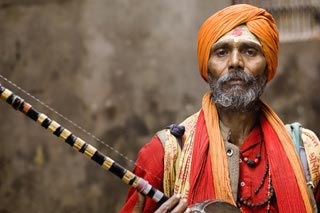
Copyright 2008 Joan Ubide
SINGER, VARANASI, 1/80 F/2 (EV-0.33) ISO 250 50MM
North India is a great country–full of contrasts… and cows. It’s a real wonder, a mystical and spiritual country–sometimes hard, sometimes tiresome, but–without a doubt–unique. I started my route in India in Gorakpur where I arrived by bus from the border of Nepal. I traveled in the packed bus suffering for my backpack, which was on the roof of the vehicle where new passengers were accommodated.
In Gorakpur, I took a train to Varanasi, one of the most amazing cities I’ve ever seen, something really special for those with a camera as a travel companion. In Varanasi, I was lucky enough to meet a guy who turned out to be from my country. We took a night train at Gorakpur station and, for
1.5 Euro a day, I spent a couple of weeks in a house with a family and a group of Catalan people who had traveled to India to learn how to play the sitar, a typical Indian instrument. The house was filled with music, plus a Serrano ham and pa amb tomaca (bread rubbed with tomato, a Catalan specialty).
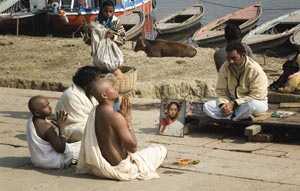
Copyright 2008 Joan Ubide
PRIDE TIME, VARANASI, 1/180 F/13 ISO 125 70MM
Varanasi is shocking for all those who arrive fresh from their “civilized” countries of origin. However, sometimes I feel India as a whole and Varanasi in particular–including the people who live there–are more civilized than many other places with clean streets and nice-smelling but neurotic people who worry only about trifles. Here people accept things as they are and don’t obsess about other people’s lives. Moreover, I could walk up and down with my camera in Varanasi without having it stolen, which is what probably would have happened in many occidental countries.
Varanasi is surrealistic, as is nearly all the country. It’s a trouble-free and somewhat chaotic mix of men, women, bohemians, monkeys, dogs, rats, rickshaws, tuc-tucs (taxis), and hundreds of cows that turn the streets into mine fields. It’s also amazing. After several days of adapting to the new environment, I found it captivating—as did several other people whom I was lucky enough to meet.
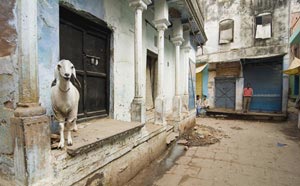
Copyright 2008 Joan Ubide
VARANASI, 1/80 F/6.3 (EV+0.67) ISO 200 12MM
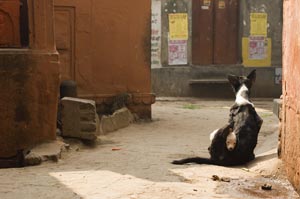
Copyright 2008 Joan Ubide
DOGS IN VARANASI, 1/125 F/5 ISO 100 50MM
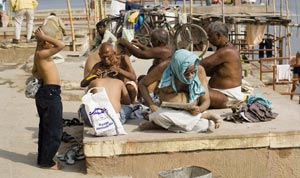
Copyright 2008 Joan Ubide
SHAVING, VARANASI, 1/640 F/6.3 ISO 100 50MM
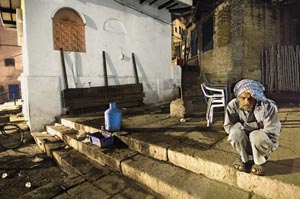
Copyright 2008 Joan Ubide
VARANASI at 04:30 AM, 0,3S F/4 ISO 250 12MM
Varanasi is not a place you can visit in one or two days. You must stay there, become familiar with the people drinking chai in the street, visit hidden spots, and participate in their rituals. This is how you will truly know Varanasi and can say you’ve been to India. Nevertheless, if you’re the fussy type, you’d better not go to India…or do go and change your attitude.
What does “surrealistic” mean in Varanasi? In one day during one of my trips to pay three rupees to have a chai in a street stall, I saw all of the following:
- A bull trying to mate a cow. The cow didn’t want to, and the all the running and charging caused quite a chaos among the pedestrians.
- A monkey stealing an apple from a vegetable stall.
- Two dogs fighting.
- A rat walking like an equilibrist on electric cables.
- A poor man, who was affected from by leprosy and had no legs, using something resembling a skateboard to move as he begged for a few rupees.
- At the same time, another cow tried to eat vegetables from another stall while the saleswoman scared it away with a stick, simultaneously holding an old weighing scale with a coupe of oranges in it in his other hand.
- And, in the background, a policeman holding an old rifle, and a group of people, singing and smiling, heading to the gath with a defunct.
And all this in only a few minutes. I looked at the man who was preparing my chai, and we smiled at each other as if I were telling him “Wow!” And he said, “That’s the way it is around here. Welcome to India!”
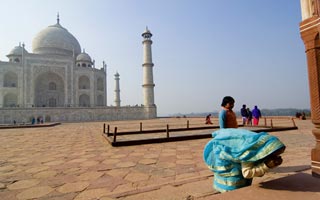
Copyright 2008 Joan Ubide
TAJ MAHAL, AGRA, 1/350 F/10 ISO 100 12MM
I can accept all this. I would even say that, after a few weeks of living here, I like it. However, what I loathe about India is that even though it’s a country with enough potential to build transoceanic, supersonic missiles, it still has people literally dying in the streets. During the past months I’ve seen really hard scenes, ones that make you lose sleep and remind you to feel very fortunate. So, after a few days in Varanasi, where I celebrated New Year’s Eve aboard a small boat in the Ganges, I headed to Agra. In Agra, after paying 750 rupees, I visited the Taj Mahal. It’s a real wonder, although not as impressive as I thought it would be.
Around the temple in Agra, you can see how Indians became famous for pestering tourists. They go on and on with the same questions, all seeking a few rupees. In Agra, you can easily loathe India, but you get used to it. There’s no way out of it. When you get off a bus or a train, you have fifty people offering you a taxi and a hotel. It’s a horribly stressing situation. The best you can do is look down and walk fast while saying, “No, thanks.” Once you’re out of the chaos, you can start to negotiate for a taxi, because surely one of the fifty representatives will be more tenacious than the rest and follow you for several minutes. A big mistake is to stop in front of the group and say, “Taxi?” Who is going to get the client?
After a couple of days in Agra (more than enough) I headed to Orchaa, a small village South of Agra–very advisable. There are lots of temples there, and it’s very quiet. There’s only a main street, and the rest is open field. Next, from Agra, I took a train for thirty-five never-ending hours, to spend a few days by the sea. In Goa, I enjoyed rest, Carnival pictures, and I was off to Delhi.
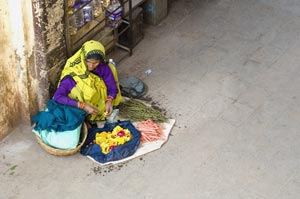
Copyright 2008 Joan Ubide
WOMAN, ORCHAA, 1/80 F/5 ISO 100 78MM
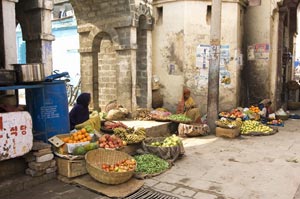
Copyright 2008 Joan Ubide
CORNER IN ORCHAA, 1/60 F/9 ISO 100 24MM
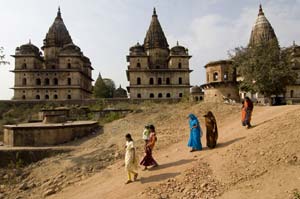
Copyright 2008 Joan Ubide
TEMPLES IN ORCHAA, 1/160 F/13 ISO 100 15MM
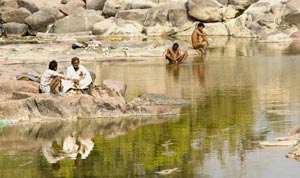
Copyright 2008 Joan Ubide
BATH, ORCHAA, 1/125 F/10 ISO 100 200MM
In Delhi, all the backpackers on a low budget gather at the Main Basar, an excellent place to stay, as it’s very close to one of the main train stations. Incidentally, you have to be careful in the train stations. People will try to rip you off saying the ticket office for foreigners has been relocated. It’s a scam. They’ll take you to an office and try to sell you a package. The ticket office for foreigners is on the first floor, and it’s very easy to buy tickets.
Another common scam occurs when you arrive in Delhi by plane. The taxi driver will take you to a travel agency, on the pretext that you have to confirm your hotel before going there. The call is a fake, and they’ll try to sell you another package. If that should happen, be firm. If necessary, shout, and they will smile and say, “Okay, okay,” as if nothing is amiss.
From Delhi, I took a train to the north to Haridwar (110 rupees seated), from Haridwar to Rishikesh (train: 5 rupees, although you can get there by tuc-tuc for 35 rupees). In Rishikesh, it’s advisable to stay in Lashman Jaula, a yoga Mecca. In this area, the sunrise and sunset ceremonies in the Ganges are worth seeing. The ceremonies are amazing, but hard if you see them in Haridwar, since that’s where the poorest people gather. During the sunrise ritual, beggars and sick people approach you to ask for a few rupees, and you can’t do anything to help them.
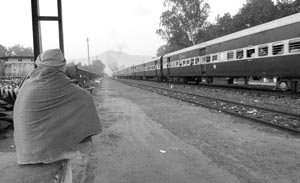
Copyright 2008 Joan Ubide
TRAIN STATION IN HARIDWAR, 1/160 F/6.3 ISO 250 14MM
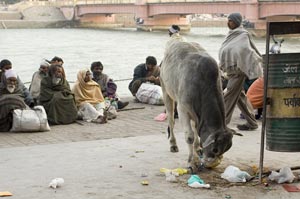
Copyright 2008 Joan Ubide
HARIDWAR, 1/90 F/4.8 ISO 125 50MM
After a few days in the north, I started a route along the villages of the Rajhastan region, probably the most beautiful and mystic part of India. Cities like Jhaipur, Pushkar, Jodhpur, Jaisalmer, and Udaipur are a must. If you have the time,
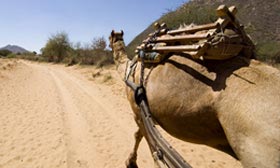
Copyright 2008 Joan Ubide
CAMEL RIDING, 1/320 F/8.5 iso 100 12mm
I recommend going from Pushkar to Podhpur riding a camel (five days, 40 Euros). Rajasthan and the travel by camel between Pushkar and Jodpur were the best times I had in all of India. There you can find truly great people and share your time with them. They have a rural way of life, living in little houses, most of them made of mud and straw. When they see you arrive, all the family comes out to greet you. They want you to stop and visit their home, to have chai with them –a chai as simple as milking the goat or cow and there you are. Chai-chai is ready! Again, those who have less are those who give you more. I recommend this experience, if you have the time for it. However, you have to know that you sleep in the open country, and everyday you eat more or less the same fare. Plus, your kidneys will be absolutely battered by the end of the trip. (The price is around 4,000 rupees for two people for five days of travel.)
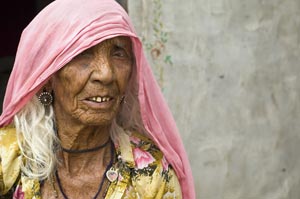
Copyright 2008 Joan Ubide
OLDER WOMAN IN RAJASTHAN VILAGE, 1/100 F/5 ISO 100 50MM
Finally, I would like to mention a few negative aspects of India. Besides the poverty and sick people living badly in the street, I must say that if you are a woman and traveling alone, you will feel observed and harassed in many places. My advice is to wear local clothes, use a headscarf, and totally ignore those who harass you. If they’re really a bore, yell at them to leave you alone. They’ll laugh and go, “Okay, okay.” Another thing I loathe about this beautiful country is their fooling-about with prices. It’s all about bargaining, but you get used to it.
CONTINE with the article: Travel Facts & Tips, North India Map and more photos…
To see more photos on Joan’s trek through North India, visit…
Visit Part 1: Mongolia
Visit Part 2: China
Visit Part 3: Tibet
Visit Part 4: Nepal
Visit Part 6: South India
Visit Part 7: Iran
by Joan Ubide

Leave a Reply